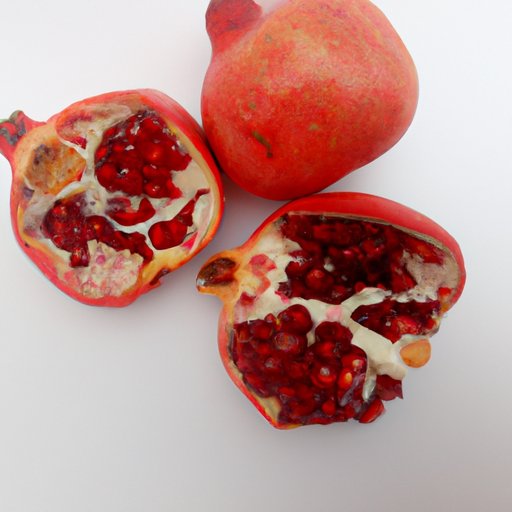Introduction
Pomegranates are a nutritious and delicious fruit that have been enjoyed by people around the world for centuries. They are packed with vitamins, minerals, and antioxidants that can help boost your health. But if you’ve never eaten a pomegranate before, you might be wondering how to go about it. In this article, we’ll explore why you should eat pomegranate, provide a step-by-step guide on how to eat one, discuss the health benefits of pomegranate consumption, share some creative recipes for incorporating pomegranates into your diet, and offer tips for storing and preserving fresh pomegranates.
Why Eat Pomegranate?
The pomegranate is a nutrient-dense fruit that has been enjoyed for centuries. It has been linked to several health benefits, including improved heart health, anti-inflammatory properties, and more. According to a study published in the journal Nutrients, “Pomegranate is a rich source of polyphenols, which are phytochemicals known for their antioxidant activity and ability to reduce oxidative stress.”
In addition to being good for your health, pomegranates also add a unique flavor to dishes. They have a sweet-tart taste that pairs well with both sweet and savory recipes. Plus, they’re easy to find in most grocery stores and can be enjoyed year-round.
Step-by-Step Guide to Eating Pomegranate
Eating a pomegranate is simple and straightforward. Here’s a step-by-step guide to help you get started:
How to Select the Best Pomegranates
When shopping for pomegranates, look for ones that are plump and heavy for their size. The skin should be smooth and unbroken, with no signs of shriveling or discoloration. Also, give the pomegranate a gentle squeeze; it should feel firm but not too hard. Avoid any pomegranates that are soft or have bruises or cuts in the skin.
Preparing and Eating a Pomegranate
Once you’ve selected a ripe pomegranate, you’re ready to prepare and eat it. To start, cut the top off the pomegranate and remove the crown. Then, score the skin from top to bottom in four sections, being careful not to cut too deeply. Gently peel back each section of the skin and remove the seeds. Finally, enjoy the seeds as is or add them to salads, smoothies, yogurt, oatmeal, or other recipes.
Health Benefits of Eating Pomegranate
Now that you know how to select and prepare pomegranates, let’s take a closer look at the health benefits of eating them. Here are just a few of the ways that pomegranates can benefit your health:
Nutritional Value
Pomegranates are an excellent source of vitamins, minerals, and antioxidants. They are particularly high in vitamin C, potassium, and fiber. According to a study published in the journal Food Chemistry, “Pomegranate fruits contain significant amounts of phenolic compounds, such as ellagic acid, anthocyanins, and tannins, which are associated with positive health benefits.”
Heart Health Benefits
Regularly consuming pomegranates may also help to improve your heart health. A study conducted by the American Heart Association found that drinking 8 ounces of pomegranate juice three times a week for a year led to a decrease in cholesterol levels and a decrease in arterial plaque.
Anti-Inflammatory Properties
Pomegranates are also believed to have anti-inflammatory properties. A study published in the journal Nutrition Research found that pomegranate extract was able to reduce inflammation in mice. It is thought that the antioxidants and polyphenols present in pomegranates may be responsible for these anti-inflammatory effects.

Creative Recipes for Pomegranate Dishes
Ready to incorporate pomegranates into your diet? Here are some creative recipes to get you started:
Salad Recipes
Pomegranates make a great addition to salads. Try adding them to a classic green salad, a quinoa salad, or a spinach salad. For a special touch, try making a pomegranate vinaigrette dressing.
Desserts
For a sweet treat, try making a pomegranate tart or a pomegranate ice cream. You can also use pomegranates to top cakes and cupcakes, or mix them into muffin batter.
Main Dishes
Pomegranates can also be used in main dishes. Try adding them to risotto, couscous, or roasted vegetables. You can also use pomegranate molasses to glaze meats like chicken and pork.

Tips for Storing and Preserving Fresh Pomegranates
To ensure that your pomegranates stay fresh for as long as possible, here are a few tips for storing and preserving them:
Refrigeration
Fresh pomegranates can be stored in the refrigerator for up to two weeks. Just be sure to store them in a sealed container or plastic bag to keep out moisture and odors.
Freezing
You can also freeze pomegranates to extend their shelf life. To do so, spread the seeds on a baking sheet and freeze until solid. Then, transfer the frozen seeds to an airtight container and store in the freezer for up to six months.
Canning
If you want to preserve pomegranates for longer than six months, consider canning them. This process involves sealing the pomegranates in airtight jars and processing them in a boiling water bath. Be sure to follow the instructions on your canning equipment carefully.
Conclusion
Pomegranates are an incredibly nutritious and delicious fruit that offer numerous health benefits. From improved heart health to anti-inflammatory properties, pomegranates can help to boost your overall health. Plus, they’re easy to find in most grocery stores and can be added to both sweet and savory recipes.
(Note: Is this article not meeting your expectations? Do you have knowledge or insights to share? Unlock new opportunities and expand your reach by joining our authors team. Click Registration to join us and share your expertise with our readers.)
